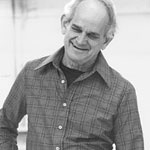
He was a marvelous man: prickly, but, at least in later years, generous-spirited and strangely, almost compulsively self-deprecating. He was by then in artist (not critic) mode, and spent most of his days brooding over his paintings in his Southern California studio, working beside his wonderful wife and partner, Patricia Patterson.
After devouring his collection Negative Space, I got to meet him in San Francisco in 1987 after a revelatory talk in which he screened bits of movies, among them the atmospheric opening of William Wellman’s Night Nurse. As I wrote in this 1994 article, he often apologized for that night — he gave the impression that what came out of his mouth was a poor compromise between what he wanted to say and what he was able to say.
In the mid-nineties, I would see him when he visited Pauline Kael, his friend of many decades. Their aesthetics diverged, but they adored each other anyway. They treasured each other’s pugnacity, and they’d both found their voices in headier, more bohemian times — Pauline in San Francisco, Manny in Greenwich Village. (At his most destitute, he crashed with James Agee.) In 1993, Pauline made a rare journey to see a retrospective of Manny’s paintings at Brandeis; I trudged around the huge space with her, with Manny keeping his distance yet unable to keep from checking in to point out this or that vegetable or mineral or phrase (the canvases are full of scrawled bits of text).
Manny could seem inscrutable yet was actually hyperprecise, which is why we kept listening, unpacking his phrases, sure that whatever came out, no matter how gnomic, contained multitudes. His writing was compacted, sometimes overly so (he would be the first to tell you that), but the words always quivered with the drive to pin down some aspect of the infinite. Once I made the mistake of saying I thought a film was “about” something. “About…” he said, softly, and glanced at Patricia. “How can we say what a film is ‘about’? There are so many things…”
He was rangy, fine-boned, constantly rejuvenated by long walks around the nearby La Jolla lagoon and by the act of trying to capture his world in those canvases. The last time I saw him, at a retrospective three years ago at P.S. 1, he was frail and somewhat more tentative, but even in his melancholy there was a kind of enchantment. He knew, I think, that he’d never see me or many of the friends who came out that day again. But he seemed to be serene in his work; he could live with that.
Here is what I wrote about a 1994 New York Manny Farber retrospective in this magazine: "A Painter, But Still a Critic."